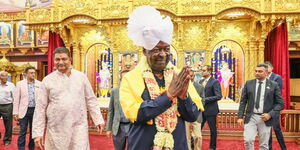When Joel Jackson, a British national, set foot in rural Kenya in 2008 while working with a micro-forestry social enterprise, he did not expect to come up with the idea of starting the first Kenyan company to design and build vehicles from scratch.
What began for Jackson as a sojourn in rural economic development evolved into the formation of Mobius Motors, Kenya’s pioneer company in the mass production and sale of locally engineered vehicles.
Detailing his journey to founding Mobius, Jackson stated that while working in Western Kenya, he noticed that many people, especially in rural areas, struggled with poor road infrastructure and a lack of affordable vehicles.
The available cars were either too expensive (imported models) or not suited to rough terrain, with low ground clearance and high maintenance costs.
This led the British entrepreneur to identify a gap in the African transport market, particularly in Kenya, where he envisioned a locally designed and built vehicle that would be durable, practical, and affordable for African roads.
Armed with just his idea and ambition, Jackson—who had no prior background in automotive engineering—researched low-cost vehicle design and teamed up with engineers to develop the first prototype.
In 2010, he formally established Mobius Motors Kenya Ltd in Nairobi. His goal was to design a car from the ground up, eliminating unnecessary features such as air conditioning and electric windows to keep it simple and affordable.
First Prototype: Mobius I
The first Mobius prototype, Mobius I, was a bare-bones vehicle with a tubular steel frame, designed to handle rough terrain. It was a proof of concept rather than a mass-production model. This prototype helped attract early investors, including grants and private funding.
The prototype was well received, and investors, particularly from Britain, invested millions to enable Mobius to release its flagship car. After refining the design, Mobius Motors introduced its first production model, Mobius II, in 2014. Priced at around Ksh1 million ($10,000), it was the most affordable new car in Kenya. The company set up a small-scale production facility in Nairobi, focusing on assembling vehicles using both locally available and imported parts.
A later improved version of Mobius II offered enhanced design and features such as power steering, glass windows, and an infotainment system. This iteration aimed to appeal to a broader audience by providing additional options and configurations.
Mobius Turmoil
However, despite improvements to the vehicles, revenue did not match the investment made, with Mobius incurring yearly losses. The losses stemmed from competition with second-hand imports, high taxes, and low sales.
For the year ending December 2024, Mobius announced losses exceeding one hundred million shillings, with revenues amounting to a mere Ksh500,000.
The following year, losses tripled, leaving the company on the brink of bankruptcy and liquidation. Internal wrangles further exacerbated the external challenges facing the company, culminating in the removal of Jackson, who was serving as Chief Executive Officer at the time.
Mobius’s poor performance reached a point of no return in August 2024, when the company announced it had entered voluntary liquidation, bringing an end to more than a decade of automotive development.
A New Dawn
Mobius was later granted a reprieve when it revealed that it had accepted a takeover bid from an undisclosed buyer. In March 2025, the buyer was announced as a Middle Eastern firm focused on driving businesses forward through intelligent investment and expert corporate management.
In an official statement, the company confirmed the takeover, adding that normal operations had resumed, with efforts directed towards the production of Mobius 3.
The new owners stated that production and manufacturing of the new model would be in full operation by July 2025, with the launch of the 4x4 model scheduled for December of the same year.
Additionally, the takeover saw Mobius appoint new leadership, tasked with steering the company towards greater heights and realising the vision its founder, Jackson, had for it. Details of Jackson’s current professional endeavours remain unknown.












